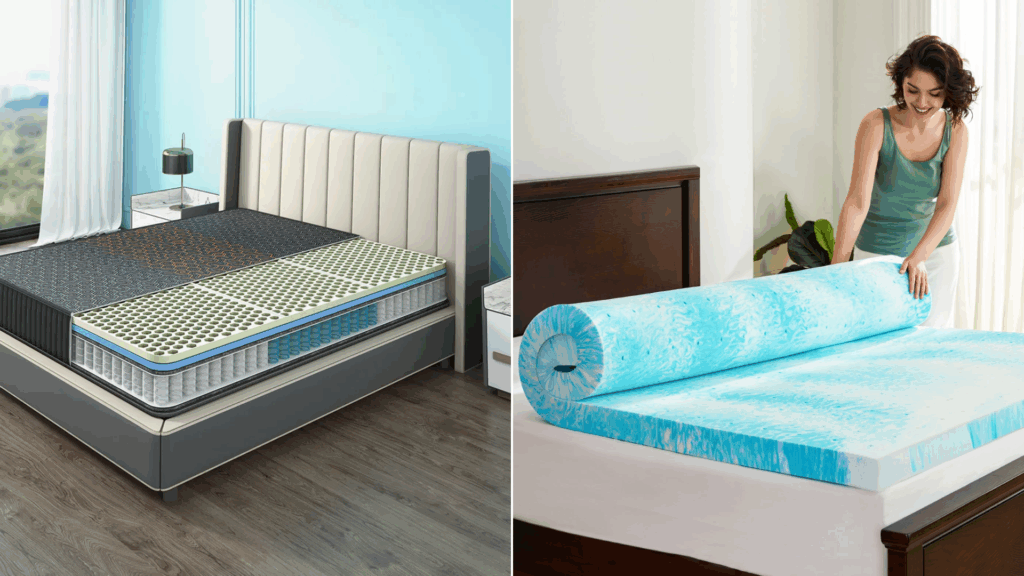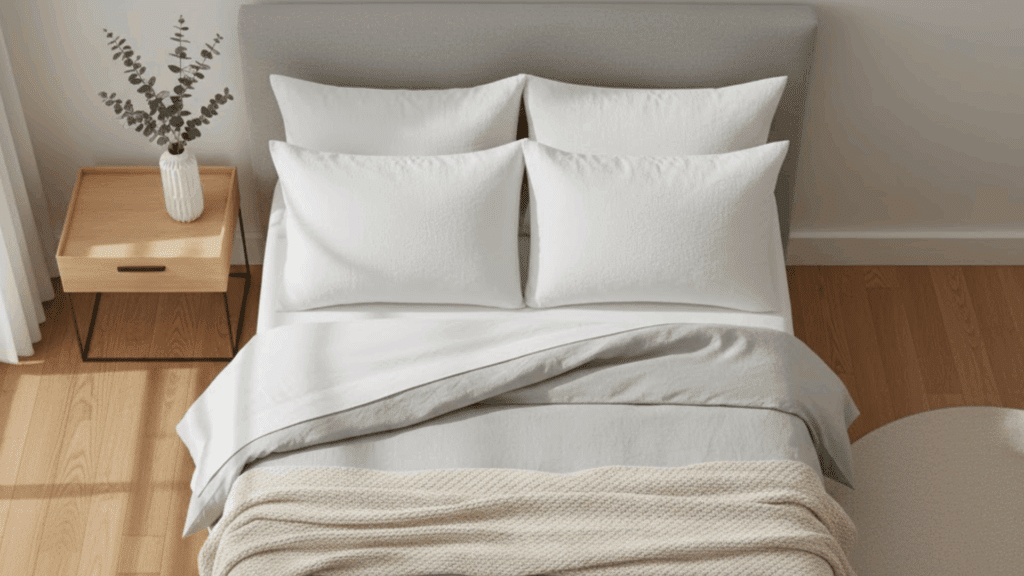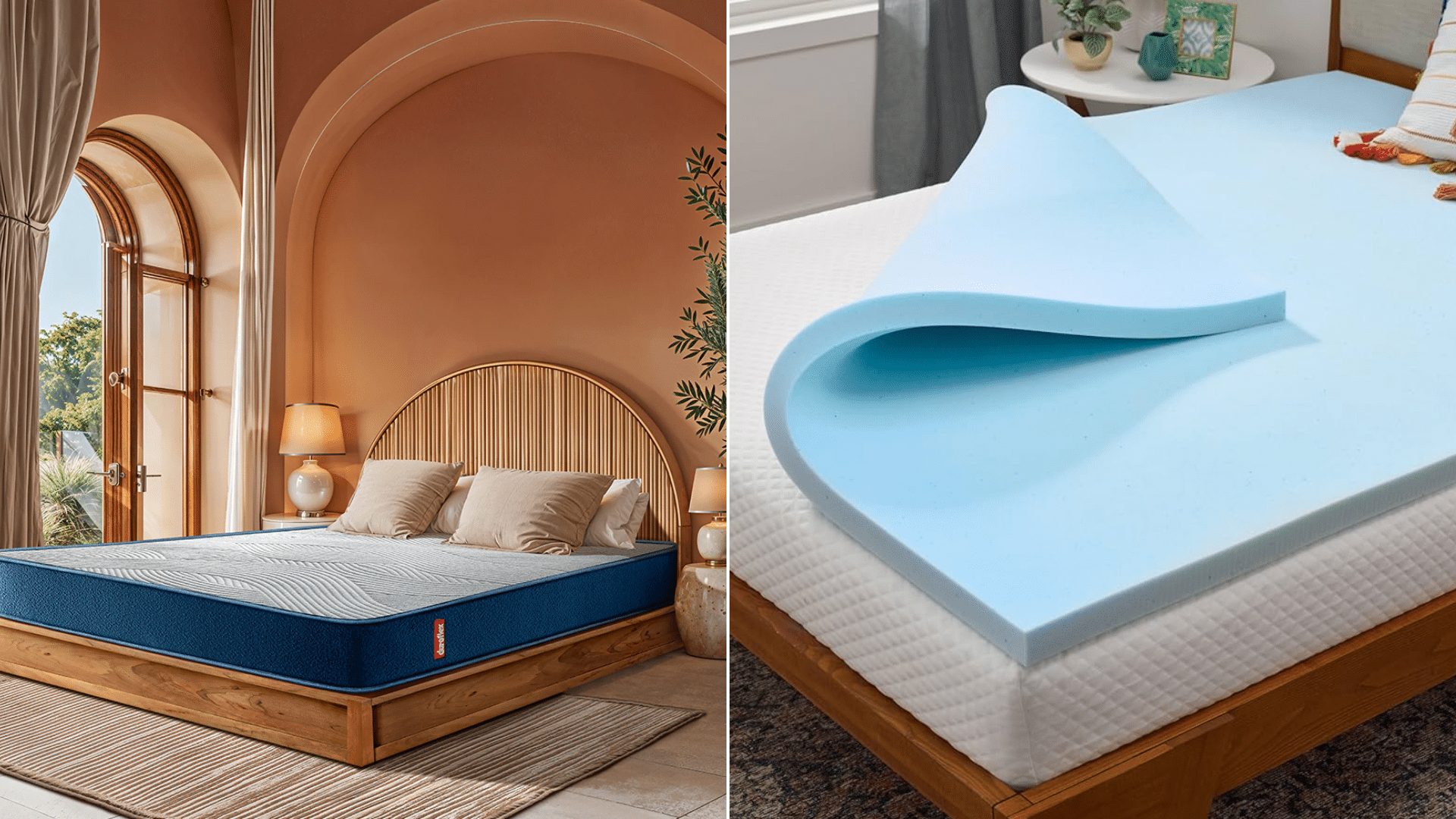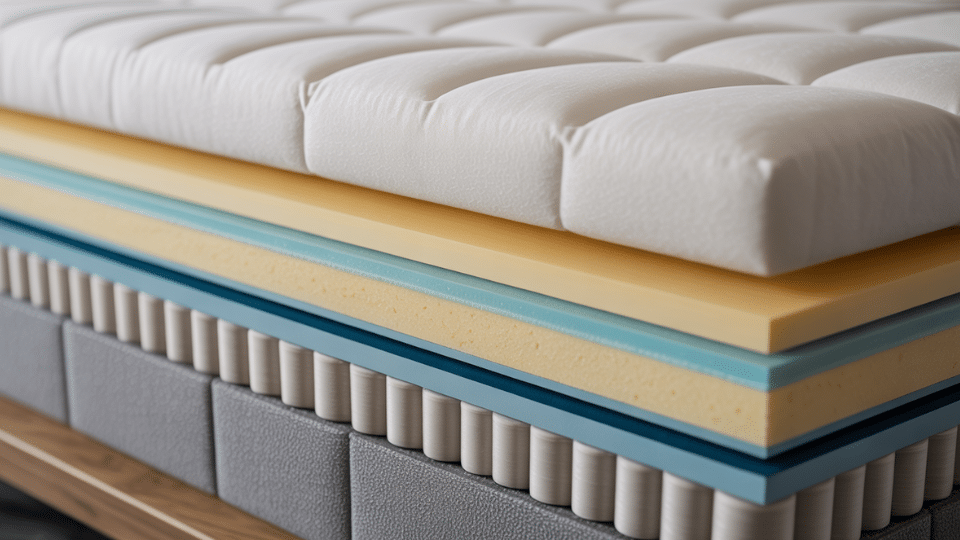I remember standing in a mattress store feeling completely unsure about what I actually needed. Maybe you’ve felt the same way.
You test one, then another, and suddenly everything feels the same. That’s usually where the hybrid vs memory foam decision becomes confusing.
You want comfort that fits your body, support that lasts, and a bed that helps you sleep better, not harder.
In this guide, I want to help you sort through the noise and understand what really matters. You’ll get clear comparisons, everyday examples, and simple guidance to help you pick the mattress that fits your sleep style.
So let’s take a closer look and make your choice much easier.
Quick Overview: How These Mattresses Differ
A hybrid mattress and a memory foam mattress feel completely different because they’re built in different ways. Hybrids mix coils with foam layers, while memory foam uses an all-foam design that hugs your body.
This difference isn’t just about feeling. Hybrids offer a lifted, stable surface with more airflow, while memory foam provides deep pressure relief and strong motion control.
When you compare hybrid vs. memory foam, it really comes down to the type of support you want, your sleep style, and how much cooling or contouring you prefer.
Hybrid vs. Memory Foam: Full Comparison Table
Understanding the main differences between hybrid and memory foam mattresses can help you choose the one that fits your comfort needs, sleep habits, and room setup.
| Feature | Hybrid Mattress | Memory Foam Mattress |
|---|---|---|
| Construction | Coils with foam layers | All-foam build |
| Feel | Lifted, steady surface | Soft, body-shaped surface |
| Bounce | More spring | Very little rebound |
| Sink | Light sink | Deep sink |
| Support | Strong lift and structure | Even body support |
| Cooling | Better airflow | Can feel warm |
| Motion Control | Moderate | Strong |
| Edge Strength | Firm edges | Softer edges |
| Weight | Heavier to move | Lighter |
| Price Range | Usually higher | Usually lower |
Hybrid mattresses give you sturdy support and better airflow, while memory foam delivers deep pressure relief and strong motion control. The right pick depends on how you want your mattress to feel every night.
Side-By-Side Comparison of Hybrid Mattress vs Memory Foam

This section helps you compare hybrid and memory foam mattresses in one place so you can understand how each feature affects daily comfort.
1. Comfort and Feel
Hybrid mattresses give you a lifted, bouncy surface that feels steady when you move. The coils add a light spring, which keeps you from sinking too deeply.
Memory foam feels very different. It softens under your body and creates a slow, contouring hug that shapes around your curves. If you like a buoyant feel and easy movement, a hybrid works well.
If you prefer a deep, cushioned hold that matches your body, memory foam is the better fit.
2. Support and Spinal Alignment
Hybrid mattresses offer lifted support because the coils hold your body up instead of letting you sink. This steady structure helps your spine stay in a more natural position.
Memory foam uses even pressure across your body to create a smooth cradle. It doesn’t lift as much, but it keeps your spine aligned by spreading weight evenly.
Hybrids feel firmer and more structured, while memory foam feels more body-shaped and gentle. Your sleep position often decides which support style works best.
3. Pressure Relief
Memory foam has a clear advantage when it comes to pressure relief. The material molds closely around your shoulders, hips, and lower back, which helps reduce tension in common pressure-point areas.
Side sleepers especially benefit from this deep contour.
Hybrid mattresses still offer pressure relief, but the coil support keeps you slightly lifted, so the cushioning isn’t as all-around.
If you want soft relief that melts pressure away, memory foam stands out. If you want balanced comfort with less sink, a hybrid performs well.
4. Cooling and Airflow
Hybrid mattresses generally stay cooler because the coil system allows strong airflow through the center of the mattress. Heat escapes more easily, so the surface feels fresher during the night.
Memory foam holds more warmth because it absorbs body heat and molds tightly around you. Some models add cooling gels or breathable foams, but they still tend to run warmer overall.
If you sleep hot or need steady temperature control, a hybrid will feel more comfortable. Memory foam works better if contouring is your priority.
5. Motion Isolation
Memory foam is the top performer for motion isolation. Its slow-moving structure absorbs movement before it spreads across the mattress, which makes it great for couples or light sleepers.
Hybrid mattresses vary because coils naturally create more bounce and movement. Some hybrids add thick foam layers to reduce motion transfer, but they rarely match the stillness of memory foam.
If you want the least disturbance when someone moves beside you, memory foam is the reliable choice. Hybrids offer stability but can’t match total isolation.
5. Edge Strength
Hybrid mattresses usually have stronger edges because the coil system gives structure around the sides. Many hybrids also include reinforced perimeter coils that help you sit or sleep near the edge without sliding off.
Memory foam mattresses tend to feel softer around the perimeter, especially after long use. The all-foam build compresses more under weight, so the edges may not feel as supportive.
If edge strength matters for sitting or shared sleeping space, hybrid mattresses provide the sturdier option overall.
6. Durability
Hybrid mattresses often last longer because metal coils keep the structure from sagging and help the mattress stay firm over time.
The combination of coils and foam slows down wear in the comfort layers. Memory foam mattresses can feel great at first, but may soften faster due to repeated compression in the same spots.
Higher-density foams improve durability, but all-foam builds still break down sooner. If you want a mattress that maintains its shape for many years, hybrids usually offer better long-term durability.
Movement, Mobility, Noise, and Bedroom Impact

Understanding how each mattress responds to body movement helps you judge comfort, convenience, and nighttime stability, especially if you shift or share your sleep space.
Changing Positions
Hybrid mattresses make changing positions easier because the coils add bounce that supports quick movement. You won’t feel stuck, and the lifted surface helps your body shift smoothly.
Memory foam responds more slowly, so movement takes extra effort, especially if you sink deeply. Its contouring feel can make rolling over or switching sides slower.
If you change positions often, hybrids feel more natural. If you prefer a relaxed, cushioned feel, memory foam offers steady comfort with less mobility.
Getting In and Out of Bed
Hybrid mattresses provide better pushback when you climb in or out because the coil system stays firm under pressure. The edges hold steady, so you can sit or rise without sliding.
Memory foam sinks more, which can make standing up slower and require more effort. The softer edges compress quickly, especially after long use.
If easy entry matters, hybrid beds feel more supportive. Memory foam works well if you prefer a soft, gentle seat before lying down.
Noise Levels
Hybrid mattresses may create slight noise from the coil system, especially when shifting weight or moving across the surface. Modern hybrids use wrapped coils to reduce sound, but light squeaks can still happen.
Memory foam is naturally quiet because it has no springs. Its dense foam absorbs movement without producing noise. If silence at night is important, memory foam stays fully silent.
Hybrids remain quiet overall, but very light coil sounds may appear over the years of regular use.
Health, Safety, and Environmental Factors
Knowing how mattresses affect indoor air, material safety, and environmental impact helps you make a cleaner, healthier, and more confident choice.
- Off-gassing levels and initial mattress smell
- Use of certified safe foams
- Low-VOC materials for better air quality
- Recycled or responsibly sourced components
- Flame-retardant methods without harsh chemicals
- Third-party certifications for safety assurance
These details help you understand how mattress materials influence health and environmental responsibility, making your final purchasing decision more informed.
Price, Ongoing Costs, and Long-Term Mattress Value
Hybrid and memory foam mattresses differ in cost, durability, and the amount of care they need over the years.
Hybrids usually cost more at the start because of their coil systems and mixed materials, but they often last longer and hold their structure better.
Memory foam mattresses tend to be more affordable upfront, which helps if you’re working with a smaller budget, though they may need to be replaced sooner.
Thinking about price, lifespan, care needs, and warranty coverage together helps you understand which mattress gives you the best overall value for your money.
Which Mattress Type Fits Different Sleep Needs the Best
Understanding who benefits most from each mattress style helps you match your sleep habits, comfort needs, and body type with the right option.
When a Hybrid Mattress is the Better Fit
Hybrid mattresses work well if you want strong support, steady lift, and easier movement throughout the night.
The coil system keeps you from sinking too deeply, which helps if you switch positions or prefer a more responsive feel. Hybrids also suit warm sleepers because the airflow keeps the surface cooler.
If you sit on the edge often or share a bed and need some extra stability, hybrids feel more secure. They’re a solid choice for sleepers wanting structure and comfort together.
When a Memory Foam Mattress Makes More Sense
Memory foam works best if you like deep body contouring and a cushioned surface that shapes closely around your pressure points.
It’s ideal for side sleepers, restless partners, and anyone sensitive to motion because the foam absorbs movement so well.
Memory foam also helps if you want a softer, more wrapped feel that eases tension in your shoulders, hips, and lower back.
If you prefer silence, gentle sink, and consistent pressure relief, memory foam offers a comforting experience that supports relaxed, steady sleep.
Conclusion
We’ve covered the key points that shape comfort, support, cooling, and long-term performance, and now you have a clearer sense of what fits your routine.
Both mattress types have strengths, and the right choice depends on how you sleep and what feels best for your body.
I hope this helped remove the confusion around hybrid vs. memory foam and made the decision feel more manageable.
If you’re ready to compare more sleep products or want ideas that improve your bedroom setup, I’d love for you to keep finding.
Check out my other blogs and see what inspires your next step.









